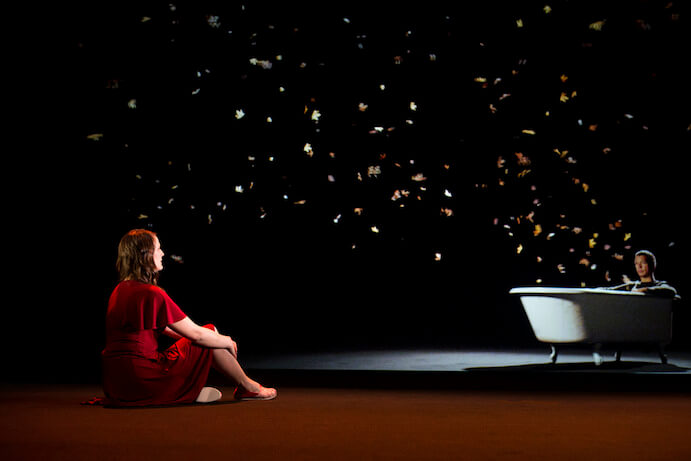On February 4, 2017 in the intimate Almi Hall of the Ooppera Baletti, Musica nova Helsinki staged the Finnish premiere of Michel Van der Aa’s Blank Out. As an artist, Van der Aa thrives at the intersection of music, film, and stage theatre, and his chamber opera Blank Out is possibly his most remarkable combination of live action and video projections to date. In a pre-concert talk, Van der Aa noted that artists are “not bound to genre anymore”—a sentiment boldly exemplified by Blank Out, which combines a single live performer, 3D video projections, spoken dialogue, a pre-recorded choir, and 80s techno beats to create an astonishing narrative inspired by the life and works of South African poet Ingrid Jonker.
Blank Out is not biographical, and the unnamed woman on stage is not meant to represent Jonker—however, Jonker’s life and works loosely influenced this chamber opera. The work begins with a woman (soprano Katherine Manley) singing an unaccompanied, disjunct recitative consisting of single words (“belly button,” “vertical”) and short, seemingly non-sensical phrases (“piles of stones”). At the end of this soliloquy, she runs toward an onstage video camera, the projection screen turns on, and the opening monologue is replayed. During the video playback, the woman on stage sings in both unison and counterpoint with her recorded self while introducing new words and phrases, at which point a tragic story begins to take shape. At the conclusion of this second cycle, a third cycle begins, now with recorded cycles one and two on the projection screen. On this third repetition, the full story emerges—in 1976, the woman watched her seven-year-old son swim away from the dike near their house and accidentally drown.
Michel Van der Aa–Photo by Marco Borggreve
The woman continues to share memories of her son while moving a 3D camera through and around a small model home, which is projected onto the screen. A hauntingly beautiful quadrophonic choral soundtrack—pre-recorded by the Nederlands Kamerkoor—accompanies her spoken dialogue. Throughout the opera, Van der Aa’s musical sensibility shines through in his vocal writing. The choral passages feature long, sustained sonorities with extended harmonies and lush consonances that provide a wistful backdrop for the action on stage. Meanwhile, the solo vocal lines maintain a lyrical, expressive quality through use of wide intervallic leaps that gently descend before soaring back to new emotional heights.
The musical interludes—which serve as a kind of incidental music—are also successful in that they capture the sound of the time period in which the action takes place: the 1980s. As the woman completes silent tasks on stage, the music launches into techno beats and glistening high frequency electronics. During one such interlude, the video on the projection screen oscillates between the woman’s model home and pre-filmed footage of an actual home in the countryside that the model is meant to replicate. Reality and the world of the on-stage model home begin to collide, and a dissonant electronic glitch announces the arrival of a man on the screen—the woman’s son, who is alive and a grown adult.
Blank Out–Photo by Minna Hätinen
The projection screen cuts back to the woman’s recorded opening soliloquies, and the man joins her on the screen to offer new perspective on the events of the tragic day in 1976. In what is now a quartet of voices (two pre-recorded videos of the woman, the live woman, and the man on the film), the man reveals that his mother dove into the water, pulled him to safety, and sacrificed her life for his. The screen shifts to a documentary-style film segment where the man (baritone Roderick Williams) remembers his mother and discusses living with the aftermath of trauma. The woman on the stage is thus a reconstructed memory, yet the music and set design begin to bridge the gap between their two worlds. They sing and dance together, and through extraordinary 3D effects, physically link their worlds with strips of film that are strung between the stage and the world on the screen. Their duet draws gorgeous lines from Jonker’s translated Afrikaans poems (“I repeat you/Without beginning or end,” “I went searching for the way of my body/and could find only the strange scars in the dust”). Eventually, the woman on stage disappears, and the man on the screen mourns her in one of the most gripping and plaintive moments of the score. The works ends as he leaves the house behind but takes memories of his mother with him.
Every element of this production was stunning. As the woman, Katherine Manley not only held the responsibility of sustaining the action on stage entirely by herself, but she was also tasked with moving video equipment, manipulating props, and performing alongside fixed, pre-recorded sound and film. In addition to mastering these technical challenges, she gave a riveting and exceptionally precise vocal performance. Roderick Williams’ powerful yet sensitive baritone was as impressionable on film as the action on the stage. Van der Aa’s libretto masterfully weaves together the poetry of Ingrid Jonker and his own texts, and the score successfully reflects both atmosphere and time. Blank Out will have its U.S. premiere at the Park Avenue Armory in September 2017, and it is a must-see production.
Blank Out – trailer from Michel van der Aa on Vimeo.

